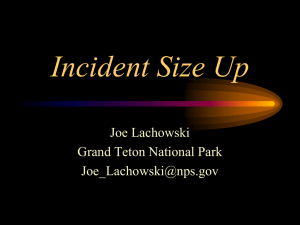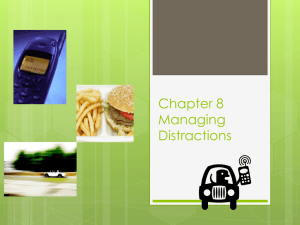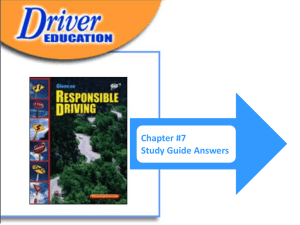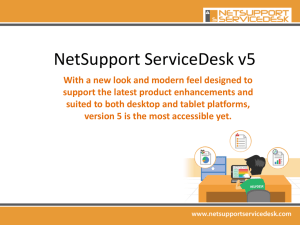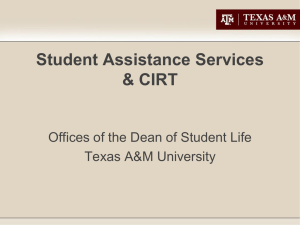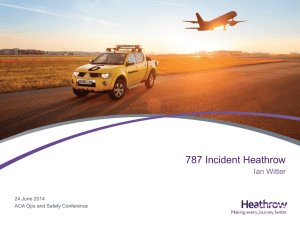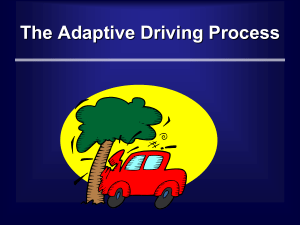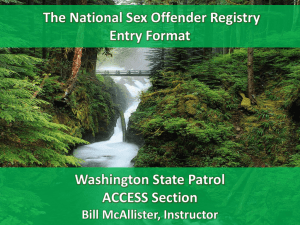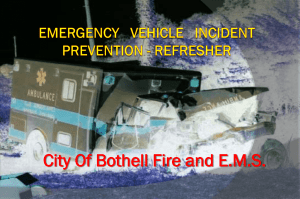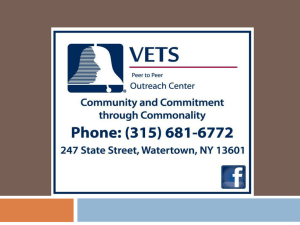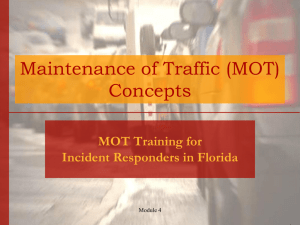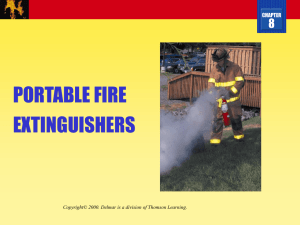1 - Florida Department of Transportation
advertisement
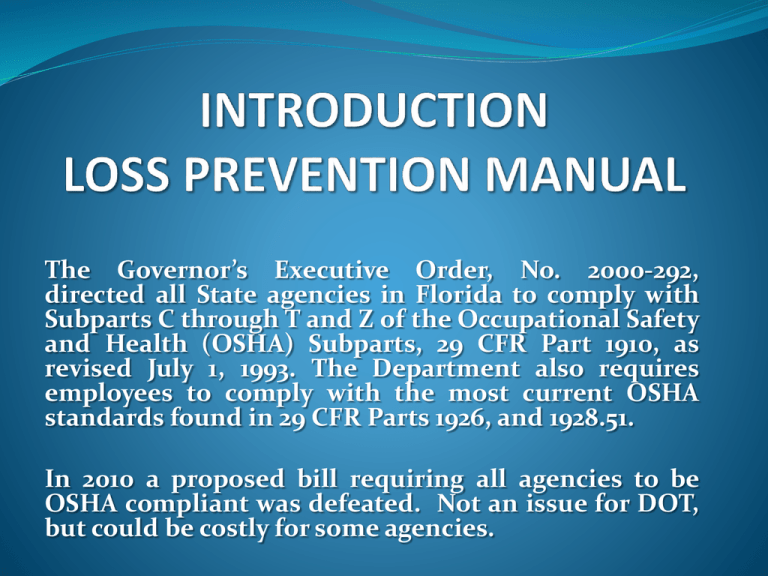
The Governor’s Executive Order, No. 2000-292, directed all State agencies in Florida to comply with Subparts C through T and Z of the Occupational Safety and Health (OSHA) Subparts, 29 CFR Part 1910, as revised July 1, 1993. The Department also requires employees to comply with the most current OSHA standards found in 29 CFR Parts 1926, and 1928.51. In 2010 a proposed bill requiring all agencies to be OSHA compliant was defeated. Not an issue for DOT, but could be costly for some agencies. DOT’s Loss Prevention Manual can be found on the DOT Infonet No. 500-000-015 Recently updated Highlighting the changes Chapter 1 RESPONSIBILITIES 1.6.3 Employees shall report any work-related incident resulting in personal injury or illness, including any crash or incident involving a Department vehicle, to their immediate supervisor or other employees designated by the Unit Manager/Office Head before the end of the employee’s shift. Chapter 1 RESPONSIBILITIES 1.8.3 Hazards can be reported by calling the “Hotline” at (850) 245-1543. Any hazard reported utilizing the “Hotline” shall receive immediate action, and will remain confidential. Chapter 2 TRAINING AND EDUCATION 2.2 SAFETY ORIENTATION Safety orientation includes general information about safety. All newly hired employees shall be given an orientation to make them aware of the importance of safety and their responsibility for maintaining a safe work environment. Appropriate safety personnel or designated person shall conduct safety orientations within thirty (30) working days of employment. Safety orientation presents general information about safety policies, safety procedures, rules, and regulations and safety awareness, document Safety Orientation in TRESS using Course Number ST-09-0197. Chapter 2 TRAINING AND EDUCATION 2.4 TRAINING The Unit Manager/Office Head shall ensure that safety training is provided to all employees for specific tasks or operations described in Chapter 12. All safety training shall be documented in TRESS Course Roster,(without PDH), Form No. 260-0250-03. Chapter 3 INCIDENT REPORTING AND INVESTIGATION PROCESS 3.1 REPORTING OF INCIDENTS 3.1.1 All incidents that result in personal injury, illness, or property damage shall be immediately reported and investigated, regardless of the extent of injury, illness, or property damage. Employees must report incidents before the end of the employee’s shift to their immediate supervisor. Chapter 3 INCIDENT REPORTING AND INVESTIGATION PROCESS 3.2.2 Any incident which results in an employee related work activity, fatality on facilities or properties owned, leased, or regulated by the Department must be reported immediately to the respective District Secretary or Assistant Secretary. Chapter 3 INCIDENT REPORTING AND INVESTIGATION PROCESS 3.3 INVESTIGATION OF ACCIDENTS INCIDENTS* 3.3.1 The purpose of an incident investigation is to gather information and record facts about the incident that caused the injury, illness, or property damage and educate and train those involved and to prevent future recurrences. *There are no accidents – someone doing something wrong, stupid, illegal, etc., caused the incident to happen. The word accident should be removed from your vocabulary as we have attempted to do in the LPM, but we missed 1 or 2 and will fix those. Chapter 3 INCIDENT REPORTING AND INVESTIGATION PROCESS 3.6 DRIVER RECORD CHECKS (Now performed by Personnel Office) All Department employees will have their driver records checked monthly by the State Safety Office, and any unacceptable driving records will be sent to the Districts and to appropriate cost center managers in the Central Office. It will then become the managers’ responsibility to take the appropriate action based on the employee’s need to drive, either to perform the job duties of the position or occasionally to perform Department’s business, in accordance with the requirements of Driver’s Record Requirements, Procedure No. 250-000-010 Chapter 4 PERSONAL INJURY/ILLNESS REPORTING 4.1.2 The Immediate Supervisor shall: (B) Call the Managed Care Provider (contact your Workers’ Compensation Coordinator for the current phone number) who will provide instructions where the injured employee should go for medical treatment. (C) As soon as the needs of the injured or ill employee are taken care of, conduct an investigation of the incident, and fill out Sections C and D (1)of the Injury/Illness Report, No. Form 500-000-18 (D) Forward the report to the Unit's Safety and Health Specialist or designee. Chapter 4 PERSONAL INJURY/ILLNESS REPORTING 4.1.3 The Unit's Safety and Health Specialist or designee shall: (A) Provide assistance, if needed, in investigating the incident. (B) Fill out Section D (2) of the Injury/Illness Report (Form No. 500-000-18), indicating recommendations for preventive action(s). (C) Forward the report to the Unit Manager/Office Head. Chapter 4 PERSONAL INJURY/ILLNESS REPORTING 4.1.4 The Unit Manager/Office Head shall: (A) Review the report and complete Section D (3) of Form No. 500-000-18 indicating the corrective action(s) to be taken. (B) Forward a copy of the completed report to the District Safety and Health Manager or designated person. For Central Office, the completed report should be forwarded to the State Safety Office, Industrial Safety, MS 53. (C) The information shall be input into Industrial Safety Information Management System within 30 calendar days by the authorized department. Chapter 5 VEHICLE CRASH/INCIDENT REPORTING PROCESS 5.2 DEFINITIONS 5.2.1 Vehicle Crashes – A crash involving at least one motor vehicle which results in a fatality, injury, or property damage when such vehicle is in operation on a traffic lane. Any vehicular thoroughfare open to the public, is considered a traffic lane. Vehicle crashes also include: (A) Crashes involving off-road motorized equipment being operated on a traffic lane. (B) Crashes involving a privately owned vehicle, or a leased or rented vehicle used by a Department employee on official business. (C) All backing incidents. Chapter 5 VEHICLE CRASH/INCIDENT REPORTING PROCESS 5.3 VEHICLE CRASH 5.3.1 In the event of a vehicle crash, the driver shall: (C) Call law enforcement (FHP first) to report the accident*. If law enforcement will not respond because there is minimal or no damage and there were no injuries, then request an accident case number and include this number on the crash report. Chapter 6 WORKPLACE SAFETY COMMITTEES 6.4.1 A chairperson shall be selected by the committee, or by the District or Central Office health and safety manager, to organize and conduct the meetings. Chapter 7 SAFETY AWARENESS 7.3.2 The following activities shall be given consideration for an awareness program: (A) Safety Meetings: Both on and off-the-job safety related subjects may be topics for safety meetings (see paragraph 7.3.2A(2) of this Manual). Safety themes provided for each month in the Department's "Safety Advisor" may also be used as topics for the meetings. (1) Meetings will be conducted by the supervisor or any other employee that the Unit Manager/Office Head may designate. All field employees or those employees whose job is a predominantly field work shall attend a safety meeting at least once each month. All other employees shall attend a safety meeting at least once each quarter. Adequate time should be allotted at the safety meeting for safety and health related topics, usually 30 minutes. Unless, when operational requirements arise that cannot be rescheduled, employees are required to attend the safety and health meetings. Chapter 7 SAFETY AWARENESS (C) All FDOT offices and field offices shall have safety and health bulletin boards. The boards shall be accessible to all employees during working hours. The items placed on the boards shall be limited to safety and health related topics only. Some examples are: safety publications, safety meeting minutes, safety training opportunities, and safety recognition recipients. Chapter 8 SAFETY INSPECTION 8.3 DANGER TAGS Danger tags are used to indicate that a specific piece of equipment, tool, or machine is not longer safe to use and is out of order. Any attempt to use it after it has been tagged is prohibited Chapter 8 SAFETY INSPECTION 8.3.2 Responsibility Employees shall report unsafe tools, machinery, and/or equipment to his/her supervisor. If it is determined that the item is unsafe to use contact the designated employee authorized to place a Danger Tag on the unsafe item. Chapter 9 FIRST AID/MEDICAL ASSISTANCE No Changes Chapter 10 STANDARDS FOR SAFE WORK PRACTICE 10.2.2 Lifting. Before attempting to manually handle any load, the employee shall: (4) To the extent feasible use your legs to push up and lift the load straight up, smoothly and evenly, not the upper body or back. Push with the legs; keep load close to the body. (7) Using your leg muscles, comfortably lower the load by bending the knees. When the load is securely in place, release the grip. Setting down the load properly is just as important as picking it up. Chapter 10 STANDARDS FOR SAFE WORK PRACTICE 10.3.1 Hazard Assessment and Equipment Selection 10.3.1.1 The Unit Manager/Office Head shall ensure that: (A) A written assessment is conducted to determine what hazards are present in the workplace that would necessitate the use of personal protective equipment. Chapter 10 STANDARDS FOR SAFE WORK PRACTICE 10.3.7 Hearing Protection Employees shall be required to wear hearing protection in designated work areas or operations where the Unit Manager/Office Head has determined that the noise levels exceed a time weighted average (TWA) of 85dBA. Every effort should be made to purchase equipment where the noise level has been lowered and the dBA is listed on the specifications. For older equipment, conduct assessments to determine if noise levels can be reduced through the use of noise absorption barriers or modification such as noise absorption covers for jack hammers Chapter 10 STANDARDS FOR SAFE WORK PRACTICE 10.3.8.1 Safety Harnesses, Lifelines, and Lanyards (D) Personal fall arrest systems and components subject to impact loading shall not be used again until both have been inspected by a competent person for serviceability. (G) Fall arrest systems shall be rigged so the employee can neither fall more than 6 feet nor contact any lower level. Chapter 10 STANDARDS FOR SAFE WORK PRACTICE 10.3.8.3 Working Over or Near Water (2) A life-saving skiff or boat is immediately available for rescue operations where employees are working over or adjacent to water and involving construction activities, repairing, painting or any other maintenance-related activities. [“Immediately available” means if an employee falls into the water the boat or skiff is already in the water to perform rescue operations without delay.] Chapter 10 STANDARDS FOR SAFE WORK PRACTICE 10.3.9 Safety Vests (A) All Department employees working on DOT Right of Way, regardless of the distance from the roadway, and on any other non-DOT Right of Way where there is an exposure to traffic are required to wear approved high-visibility apparel. A minimum of a Class 2 vest is required. Flaggers working at night must wear orange Class 3 apparel. (B) The requirements in Paragraph (A) also apply to rainwear. Rain coats or rain suits must be a Class 2 or 3 high-visibility apparel with reflective stripes on the sleeves, the front and the back of the rainwear or the employee must wear at least a Class 2-vest over the orange or yellow rainwear. Chapter 10 STANDARDS FOR SAFE WORK PRACTICE 10.4.1 Portable Fire Extinguishers 10.4.1.1 Appropriate portable extinguishers, suitable to the type of hazard must be readily available at all work sites, as required by NFPA 10, and in all Department Vehicles. 10.4.1.2 Fire extinguishers must be properly installed and secured using a wall hangar designed for this purpose or installed in an approved wall cabinet 10.4.1.3 Fire extinguishers in vehicles or drivable equipment must be secured and must not be located where they will create a tripping hazard for the driver or passengers. Chapter 10 STANDARDS FOR SAFE WORK PRACTICE 10.4.1.4 Portable fire extinguishers shall be conspicuously located, easily accessible, and identified through the use of signs, arrows, or other appropriate means. 10.4.1.5 No supplies, materials, tools, or cabinets will be placed near portable fire extinguishers so as to obstruct their use. NOTE: There is an annual fire prevention training requirement. Central Office training is computer based, but may also include hands on training. ST-09-0057 Chapter 10 STANDARDS FOR SAFE WORK PRACTICE 10.4.2 Fire Prevention 10.4.2.1 Housekeeping- The Unit Manager and/or designated person shall ensure proper housekeeping is maintained. (F) Vegetation must be controlled. (but not like this) Chapter 10 STANDARDS FOR SAFE WORK PRACTICE 10.4.2.2 Ignition Hazards (C) Smoking is prohibited in all the Department buildings including all storage sheds, shops, and guard shacks. [and vehicles] (E) Open flames or any other burning object (such as incense) is prohibited. The only exceptions would be the use of serving tray warmers for a special function (if approved by the building manager and supervisor) and the use of candles on birthday cake (only when they will be blown out immediately.) Chapter 10 STANDARDS FOR SAFE WORK PRACTICE 10.11.4 Vehicle Operation (A) All occupants of a motor vehicle are required to use the safety belts provided whenever the vehicle is in motion, regardless of whether they are driving on roadways in the yard, construction sites, or off-road sites. The proper use of safety belts includes the correct placement of the shoulder harness so it crosses the chest (not tucked under the occupant’s arm.) (B) Always drive within the posted speed limit and govern speed according to posted speed limits, road conditions, and traffic conditions. Operators of any state owned or leased vehicle shall report within 24 hours to their immediate supervisor if they received any citation from a law enforcement officer for any motor vehicle law violation. Chapter 10 STANDARDS FOR SAFE WORK PRACTICE 10.13.4 Other Office Safe Practices (D) Extension cords are not authorized to be used in Department buildings or facilities with the exception of the following: for temporary audiovisual support, building maintenance and construction tools and only if using an extension cord rated heavy duty. The use of a temporary power strip is authorized for attaching computers, lights, and other equipment provided the equipment will not overload the power strip and power strips are not attached together to reach a receptacle. Only multi-outlet power strips with UL approved surge suppressors are approved for use. Chapter 10 STANDARDS FOR SAFE WORK PRACTICE 10.14 INDOOR AIR QUALITY (D) These complaints can include but are not limited to: continuous sinus problems, headaches when in the building, drowsiness, watery eyes, sneezing, etc. The Loss Prevention Manual Is the Department’s key safety resource Helps you stay properly trained and safe Central Office and the District Health and Safety Managers work together to keep the manual current and useable. Questions and concerns should be discussed with your health and safety managers Mark Eacker: 850-245-1510 Marianne Trussell: 850-245-1504 QUESTIONS?
